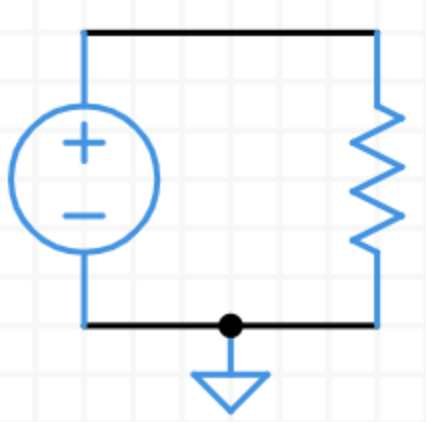Spinning Numbers
Welcome to Spinning Numbers. Learn about electricity and electrical engineering.
New — Circuit Sandbox is now available in Czech (November 2024), our tenth language.
Introduction
Become familiar with the most important electrical quantities: charge, current, and voltage.
News: The definition of the Ampere changed in 2019.
Circuit elements
Circuits are made of resistors, capacitors, inductors, and power sources.
Resistor circuits
Resistors in series and parallel, the voltage divider, delta-wye resistor networks.
DC circuit analysis
Kirchhoff’s Laws, node voltage method, mesh and loop current methods.
Special topics in DC analysis
Linearity and superposition. Source transformation. Thévenin and Norton equivalents.
Natural and forced response
Capacitor and inductor $i$-$v$ equations. Natural response is what a circuit does with its internal stored energy. Forced response is due to energy applied from outside.
AC circuit analysis
If we limit signals to only sine waves, we get AC analysis based on complex exponentials.
Special topics in AC analysis
Decibels and RMS.
Amplifiers
The operational amplifier is the building block of analog electronics.
Semiconductors
Using a diode in a circuit.
Electrostatics
Electric force is described by Coulomb’s Law. Electric field. Formal definition of voltage.
Digital electronics
Basic concepts underlying digital hardware design.
Signals
Basic concepts of signal processing. Properties of sine waves. (under development)
Circuit sandbox simulator
 Circuit Sandbox simulator with selectable language,
Circuit Sandbox simulator with selectable language,
| English | Español | Português | Français | Italiano |
| हिन्दी (Hindi) |
日本語 (Japanese) |
简体中文 (Chinese) |
Magyarul (Hungarian) |
Čeština (Czech) |
Can you help translate Circuit Sandbox into other languages? It’s easy!
Rarely asked questions
A collection of amusing, interesting, (and possibly useful), engineering questions.
What’s with the name? 
Where does the name Spinning Numbers come from?
Printing
Tips on the best way to print articles from Spinning Numbers.
Everything
List of everything on Spinning Numbers—topics, articles, videos, images, and on and on.
Greetings
These videos and articles began at Khan Academy where I had the honor of being the Electrical Engineering Content Fellow in 2016. The concepts are explained at the level of an undergraduate EE student. Motivated middle school and high school students can get a lot from the course.
Spinning Numbers web site came to life in 2016 after I completed my fellowship at KA. All the articles have been reviewed and significantly improved, and several new articles have made their appearance. A nice new feature is the Circuit Sandbox simulator. Many articles include simulation models to let you try your test your understanding and bring the concepts to life.
Good luck on your journey into electronics and electrical engineering. Please leave a comment if you enjoy your visit, and ask questions. I’m here to help.
- Willy McAllister
Questions
Why don’t you write about maths? You are a superb teacher.👍🙏💯
Here is a test
Hey Mr. McAllister. I was getting help from some of your work on KA at 1 AM and found out about this website from a comment of yours. It brings me joy to see you’re continuing your work. I am especially glad to have found this resource now that I just got knees deep into a circuit analysis course. Great timing! Thank you again!
Guilherme - Welcome to Spinning Numbers. I hope this helps you get a deeper understanding of circuit analysis, even deeper than your knees.
Hi Willy, Have you a worked example video of using Euler’s Identity in AC analysis please?
Derek - I don’t have any worked examples yet for AC analysis. When you work with and AC circuit you are looking at frequency response and phase shift using the language of filters and transforms. The complex exponentials from Euler’s Identity are embedded in things like the definition of the Fourier Transform. One related spot where we apply Euler’s Identity to an important result is here: https://spinningnumbers.org/a/lc-natural-response-derivation.html#eulers-identities
Anybody home? :)
Hi Kristina. Yes, somebody is home.
Are the videos revised as well or just the notes in this website?
Almost all of the videos are exactly what you find on KA. There are 5 videos that I’ve edited slightly to remove errors. You can see which 5 by clicking on the YouTube link at the bottom of every page.
how can I download it ???
If you want to download an article as a .pdf file, see these instructions: https://spinningnumbers.org/printing.html Is that what you are trying to do?
Mr. McAllister, My system is showing a voltage drop error Across the first resistor I have a 2.5 Volt drop Across the second resistor I have a one Volt drop Together as you see that’s 3.5 volts From a 3 Volt supply All resistors all nodes are connected correctly The ground Fire clowns seems to be a different style than the one depicted In the Class But it is indeed a ground All voltages 3 bolts Applied All resistances 1K 3K,2K Are correct Please adVISE If you know of any fixes For the system
Robert - I think your circuit is okay. You described a circuit with a 3V source in series with 1k, 3k, and 2k resistors. You are getting mixed up between “node voltage” with “element voltage”. An element voltage is what appears across a single resistor. A node voltage is different—it is measured between a node and ground. Here is the definition of node voltage: https://spinningnumbers.org/a/node-voltage.html#definition-node-voltage.
The current in the circuit is 0.5mA. The element voltage appears across a resistor. The 1k resistor has an element voltage of v = i R = 0.5mA 1k = 0.5V. One end of the 1k resistor is at 3V with respect to ground (because it is connected to the source). The node at the other end of the 1k resistor is at 2.5V with respect to ground. That’s the node voltage at that point in the circuit. Simulators work with node voltages.